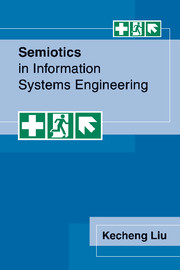Book contents
- Frontmatter
- Contents
- Preface
- 1 Introduction
- Part one Semiotic framework and methods
- 2 Understanding semiotics
- 3 A semiotic framework for information systems
- 4 A semiotic approach to information systems development
- 5 Knowledge representation and information analysis
- 6 Semantic Analysis
- 7 Pragmatics and communication
- 8 The social layer: modelling organisations as information systems
- Part two Applications
- Appendix A Semantic templates and surrogate specification
- Appendix B LEGOL applications in the CRIS case
- Bibliography
- Index
6 - Semantic Analysis
Published online by Cambridge University Press: 19 September 2009
- Frontmatter
- Contents
- Preface
- 1 Introduction
- Part one Semiotic framework and methods
- 2 Understanding semiotics
- 3 A semiotic framework for information systems
- 4 A semiotic approach to information systems development
- 5 Knowledge representation and information analysis
- 6 Semantic Analysis
- 7 Pragmatics and communication
- 8 The social layer: modelling organisations as information systems
- Part two Applications
- Appendix A Semantic templates and surrogate specification
- Appendix B LEGOL applications in the CRIS case
- Bibliography
- Index
Summary
A business system is a real information system, which is infinitely rich and complex. One can never exhaustively study a social or business organisation. What is modelled is always a part of it; and what is seen is just a realisation (or an instance) of a pattern of behaviour of some agent. If one wishes to model a business system one has to focus on the level of pattern of behaviour. The method of Semantic Analysis provides a means for these purposes by devising a canonical formalism with focus on the responsible agent and his repertoire of behaviour. This method covers a range of activities in information modelling such as requirements elicitation, analysis, specification and representation.
Theoretical aspects of Semantic Analysis
The relationship between behaviour and knowledge is in two directions. In one direction, an agent learns about the world through his actions to gain knowledge so that he gets to know exactly the meanings and boundaries of objects, concepts and relations. On the other side, the behaviour manifests knowledge that the agent possesses. The functions of both sides work at the same time, i.e., what he knows tells him what to do; what he does reflects what he knows (partially, because what he does may be a kind of trail to learn some new knowledge). Any rational action of the agent is constrained by the repertoire of behaviour and directed by his knowledge of the world. This repertoire of behaviour can be seen as affordances.
Information
- Type
- Chapter
- Information
- Semiotics in Information Systems Engineering , pp. 61 - 81Publisher: Cambridge University PressPrint publication year: 2000
